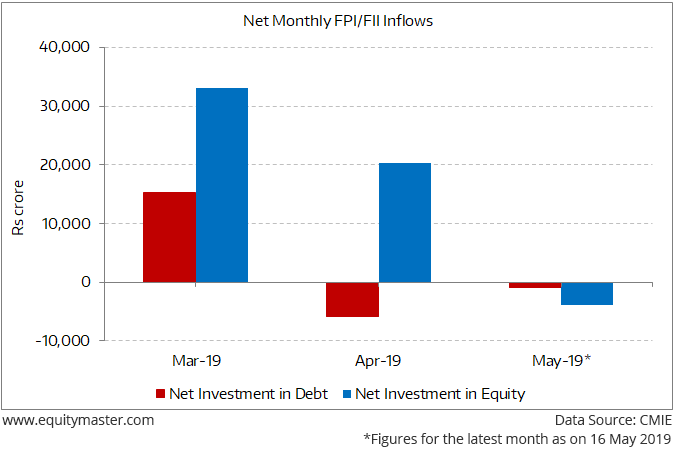- Home
- Todays Market
- Indian Stock Market News August 1, 2019
Sensex Opens in Red; Metal and IT Stocks Lose the Most Thu, 1 Aug 09:30 am
Asian share markets are mixed today. The Hang Seng is lower by 0.8% while the Nikkei 225 is even. The Shanghai Composite is trading down by 0.9%. The Dow and S&P 500 suffered their biggest daily percentage drops since May 31 on Wednesday after the Federal Reserve cut interest rates for the first time in a decade, but remarks by Fed Chair Jerome Powell dampened expectations for further cuts going forward.
Back home, India share markets opened the day on a negative note. The BSE Sensex is trading down by 161 points while the NSE Nifty is trading down by 16 points. Both, the BSE Mid Cap index and BSE Small Cap index opened up by 0.1%.
Barring consumer durables stocks, power stocks and realty stocks, all sectoral indices have opened the day on a negative note with metal stocks and information technology stocks witnessing maximum selling pressure.
The rupee is currently trading at 69.14 against the US$.
The rupee recovered from early lows to settle higher by 6 paise at 68.79 against the US dollar on Wednesday amid uncertainty ahead of the outcome of US Federal Reserve meeting.
At the interbank foreign exchange (forex), the domestic currency witnessed heavy volatility. The local unit opened lower at 68.89 a dollar and touched a low of 68.94 later.
The rupee made a recovery later in line with gains in equity markets and touched a day's high of 68.76 to US dollar.
The local unit finally closed at 68.79 against the American currency, registering a rise of 6 paise over its previous close of 68.85.
Speaking of currencies, Vijay Bhambwani, editor of Weekly Cash Alerts, tells you the main reasons why not to trade commodities and currencies the same way you would trade equities. Here's an excerpt of what he wrote...
- Currencies are traded in pairs and the most liquid is the USDINR. Currencies are traded in four decimal points just as bonds are. The international derivative trader's association has indicated that forex may be traded in 6 decimals in the coming few years.
It takes months sometimes for the currency pair to pass the next round figure, say from 70 to 71.
Can you really trade commodities and currencies alike or for that matter, equities and currencies alike? Definitely not!
To know more, you can read Vijay's entire article here: Is Trading in Equities, Commodities, and Currencies the Same?
Moving on to the news from the global markets. The Federal Reserve cut interest rates on July 31 to shore up the economy against risks including global weakness, but the head of the US central bank said he did not view the move as the start of a lengthy series of rate cuts.
Fed Chairman Jerome Powell cited global weakness, simmering trade tensions and a desire to boost too-low inflation in explaining the central bank's decision to lower borrowing costs for the first time since 2008 and move up plans to stop winnowing its massive bond holdings.
In a statement at the end of its latest two-day policy meeting, the Fed said it had decided to cut rates "in light of the implications of global developments for the economic outlook as well as muted inflation pressures."
The central bank also said it will "continue to monitor" how incoming information will affect the economy and "will act as appropriate to sustain" a record-long US economic expansion.
Speaking of the US Fed policy decision effects in India, one of the key reasons foreign investors poured money into India was the shift in monetary policy stance by the US Federal Reserve.
The US central bank, until some months ago, was on track to hike interest rates and shrink the Fed balance sheet. But seeing signs of slowdown in the economy and the nervousness in the stock markets, it showed its willingness to turn dovish.
So, it's unlikely we'll see any interest rate hikes by the US Federal Reserve in 2019.
In fact, the Fed may resume its easy money policies if the global economic slowdown persists and the markets gets jittery.
One of the key triggers for the ongoing market correction is the escalation in the US-China trade war amid increasing fears of a global slowdown.
The chart below shows how foreign money moved in and out of India over the last three months owing to the evolving global events...
Foreign Investors Turn Sellers in May 2019
To know what's moving the Indian stock markets today, check out the most recent share market updates here.
For information on how to pick stocks that have the potential to deliver big returns, download our special report now!
Read the latest Market Commentary



Equitymaster requests your view! Post a comment on "Sensex Opens in Red; Metal and IT Stocks Lose the Most". Click here!
Comments are moderated by Equitymaster, in accordance with the Terms of Use, and may not appear
on this article until they have been reviewed and deemed appropriate for posting.
In the meantime, you may want to share this article with your friends!